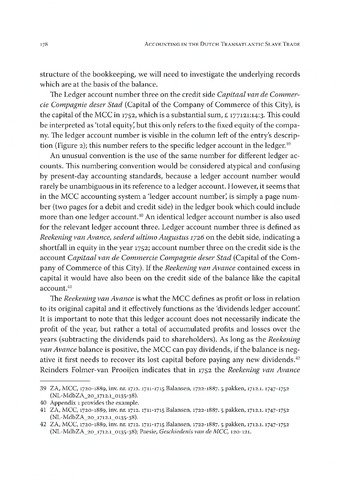structure of the bookkeeping, we will need to investigate the underlying records
which are at the basis of the balance.
The Ledger account number three on the credit side Capitaal van de Commer
cie Compagnie deser Stad (Capital of the Company of Commerce of this City), is
the capital of the MCC in 1752, which is a substantial sum, 177121:14:3. This could
be interpreted as 'total equity, but this only refers to the fixed equity of the compa
ny. The ledger account number is visible in the column left of the entry's descrip
tion (Figure 2); this number refers to the specific ledger account in the ledger.39
An unusual convention is the use of the same number for different ledger ac
counts. This numbering convention would be considered atypical and confusing
by present-day accounting standards, because a ledger account number would
rarely be unambiguous in its reference to a ledger account. However, it seems that
in the MCC accounting system a 'ledger account number, is simply a page num
ber (two pages for a debit and credit side) in the ledger book which could include
more than one ledger account.40 An identical ledger account number is also used
for the relevant ledger account three. Ledger account number three is defined as
Reekening van Avance, sederd ultimo Augustus 1726 on the debit side, indicating a
shortfall in equity in the year 1752; account number three on the credit side is the
account Capitaal van de Commercie Compagnie deser Stad (Capital of the Com
pany of Commerce of this City). If the Reekening van Avance contained excess in
capital it would have also been on the credit side of the balance like the capital
account.41
The Reekening van Avance is what the MCC defines as profit or loss in relation
to its original capital and it effectively functions as the 'dividends ledger account,
It is important to note that this ledger account does not necessarily indicate the
profit of the year, but rather a total of accumulated profits and losses over the
years (subtracting the dividends paid to shareholders). As long as the Reekening
van Avance balance is positive, the MCC can pay dividends, if the balance is neg
ative it first needs to recover its lost capital before paying any new dividends.42
Reinders Folmer-van Prooijen indicates that in 1752 the Reekening van Avance
178
Accounting in the Dutch Transatlantic Slave Trade
39 ZA, MCC, 1720-1889, inv. nr. 1712. 1711-1715 Balansen, 1722-1887. 5 pakken, 1712.1. 1747-1752
(NL-MdbZA_20_1712.1_0135-38).
40 Appendix 1 provides the example.
41 ZA, MCC, 1720-1889, inv. nr. 1712. 1711-1715 Balansen, 1722-1887. 5 pakken, 1712.1. 1747-1752
(NL-MdbZA_20_1712.1_0135-38).
42 ZA, MCC, 1720-1889, inv. nr. 1712. 1711-1715 Balansen, 1722-1887. 5 pakken, 1712.1. 1747-1752
(NL-MdbZA_20_1712.1_0135-38); Paesie, Geschiedenis van de MCC, 120-121.

